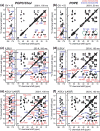Conformation and Trimer Association of the Transmembrane Domain of the Parainfluenza Virus Fusion Protein in Lipid Bilayers from Solid-State NMR: Insights into the Sequence Determinants of Trimer Structure and Fusion Activity
- PMID: 29330069
- PMCID: PMC5831503
- DOI: 10.1016/j.jmb.2018.01.002
Conformation and Trimer Association of the Transmembrane Domain of the Parainfluenza Virus Fusion Protein in Lipid Bilayers from Solid-State NMR: Insights into the Sequence Determinants of Trimer Structure and Fusion Activity
Abstract
Enveloped viruses enter cells by using their fusion proteins to merge the virus lipid envelope and the cell membrane. While crystal structures of the water-soluble ectodomains of many viral fusion proteins have been determined, the structure and assembly of the C-terminal transmembrane domain (TMD) remains poorly understood. Here we use solid-state NMR to determine the backbone conformation and oligomeric structure of the TMD of the parainfluenza virus 5 fusion protein. 13C chemical shifts indicate that the central leucine-rich segment of the TMD is α-helical in POPC/cholesterol membranes and POPE membranes, while the Ile- and Val-rich termini shift to the β-strand conformation in the POPE membrane. Importantly, lipid mixing assays indicate that the TMD is more fusogenic in the POPE membrane than in the POPC/cholesterol membrane, indicating that the β-strand conformation is important for fusion by inducing membrane curvature. Incorporation of para-fluorinated Phe at three positions of the α-helical core allowed us to measure interhelical distances using 19F spin diffusion NMR. The data indicate that, at peptide:lipid molar ratios of ~1:15, the TMD forms a trimeric helical bundle with inter-helical distances of 8.2-8.4Å for L493F and L504F and 10.5Å for L500F. These data provide high-resolution evidence of trimer formation of a viral fusion protein TMD in phospholipid bilayers, and indicate that the parainfluenza virus 5 fusion protein TMD harbors two functions: the central α-helical core is the trimerization unit of the protein, while the two termini are responsible for inducing membrane curvature by transitioning to a β-sheet conformation.
Keywords: conformational plasticity; magic-angle-spinning NMR; spin diffusion; trimer formation.
Copyright © 2018 Elsevier Ltd. All rights reserved.
Figures









Similar articles
-
Oligomeric Structure and Three-Dimensional Fold of the HIV gp41 Membrane-Proximal External Region and Transmembrane Domain in Phospholipid Bilayers.J Am Chem Soc. 2018 Jul 5;140(26):8246-8259. doi: 10.1021/jacs.8b04010. Epub 2018 Jun 22. J Am Chem Soc. 2018. PMID: 29888593 Free PMC article.
-
Viral fusion protein transmembrane domain adopts β-strand structure to facilitate membrane topological changes for virus-cell fusion.Proc Natl Acad Sci U S A. 2015 Sep 1;112(35):10926-31. doi: 10.1073/pnas.1501430112. Epub 2015 Aug 17. Proc Natl Acad Sci U S A. 2015. PMID: 26283363 Free PMC article.
-
Solid-State Nuclear Magnetic Resonance Investigation of the Structural Topology and Lipid Interactions of a Viral Fusion Protein Chimera Containing the Fusion Peptide and Transmembrane Domain.Biochemistry. 2016 Dec 13;55(49):6787-6800. doi: 10.1021/acs.biochem.6b00568. Epub 2016 Nov 29. Biochemistry. 2016. PMID: 27766858
-
Structural and functional specificity of Influenza virus haemagglutinin and paramyxovirus fusion protein anchoring peptides.Virus Res. 2017 Jan 2;227:183-199. doi: 10.1016/j.virusres.2016.09.014. Epub 2016 Oct 20. Virus Res. 2017. PMID: 27773768 Review.
-
Membrane protein structure and dynamics from NMR spectroscopy.Annu Rev Phys Chem. 2012;63:1-24. doi: 10.1146/annurev-physchem-032511-143731. Epub 2011 Nov 28. Annu Rev Phys Chem. 2012. PMID: 22136620 Free PMC article. Review.
Cited by
-
Oligomeric Structure and Three-Dimensional Fold of the HIV gp41 Membrane-Proximal External Region and Transmembrane Domain in Phospholipid Bilayers.J Am Chem Soc. 2018 Jul 5;140(26):8246-8259. doi: 10.1021/jacs.8b04010. Epub 2018 Jun 22. J Am Chem Soc. 2018. PMID: 29888593 Free PMC article.
-
Virus Structures and Dynamics by Magic-Angle Spinning NMR.Annu Rev Virol. 2021 Sep 29;8(1):219-237. doi: 10.1146/annurev-virology-011921-064653. Annu Rev Virol. 2021. PMID: 34586870 Free PMC article. Review.
-
Conformational plasticity underlies membrane fusion induced by an HIV sequence juxtaposed to the lipid envelope.Sci Rep. 2021 Jan 14;11(1):1278. doi: 10.1038/s41598-020-80156-w. Sci Rep. 2021. PMID: 33446748 Free PMC article.
-
Parainfluenza virus entry at the onset of infection.Adv Virus Res. 2021;111:1-29. doi: 10.1016/bs.aivir.2021.07.001. Epub 2021 Aug 23. Adv Virus Res. 2021. PMID: 34663496 Free PMC article.
-
Biochemical Analysis of Coronavirus Spike Glycoprotein Conformational Intermediates during Membrane Fusion.J Virol. 2019 Sep 12;93(19):e00785-19. doi: 10.1128/JVI.00785-19. Print 2019 Oct 1. J Virol. 2019. PMID: 31315988 Free PMC article.
References
-
- Eckert DM, Kim PS. Mechanisms of viral membrane fusion and its inhibition. Annu. Rev. Biochem. 2001;70:777–810. - PubMed
Publication types
MeSH terms
Substances
Grants and funding
LinkOut - more resources
Full Text Sources
Other Literature Sources

